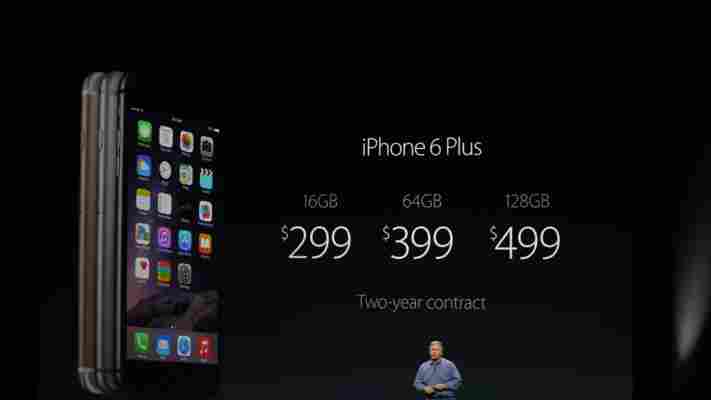Apple is back with the latest iteration of its wildly successful smartphone, the iPhone. Today, the company introduced two new models: The 4.7-inch iPhone 6 and 5.5-inch iPhone 6 Plus.

Both models sport curved edges and rounded corners, creating a more unified and welcoming design. Apple says the back has been constructed from anodized aluminium and features a premium, stainless steel Apple emblem.
The iPhone 6 is the smaller of the two new handsets, with a 4.7-inch display and a 1334 x 750 pixel resolution. Meanwhile, the iPhone 6 Plus sports a larger 5.5-inch panel and a more pixel-dense 1920 x 1080 resolution. Both are considered “Retina HD” screens, which Apple describes as a “new generation” of displays for its high-end smartphones. To put that in perspective, the iPhone 6 Plus features 185 percent more pixels than the current iPhone 5s.
Both devices are luxuriously thin too. The iPhone 6 comes in at 6.9mm, while the larger iPhone 6 Plus manages a bulkier, but still attractive 7.1mm. Both are skinnier than the already sleek iPhone 5s, which measured 7.6mm on the side.
With a larger display comes changes to the overall software experience. Showing the iPhone 6 and 6 Plus side-by-side, Apple was able to show how various apps would look different on the two devices. Turning either handset on its side reveals an altered UI too, similar to Apple’s popular iPad tablets. The home screen will also change automatically in this new landscape mode, ensuring the app icons are always facing the right way up.
Both the iPhone 6 and iPhone 6 Plus feature a new gesture called “reachability,” which pulls the entire screen down into the bottom half. The upper section is left entirely blank and it’s designed to help you select buttons and links that would normally be difficult to reach. These features form part of iOS 8, which Apple detailed at length during its Worldwide Developer Conference (WWDC) in June.
On the hardware side, the power button has been repositioned on the side. This was expected and is identical to the large majority of Android smartphones that sport equally large displays. In short, having a power button right at the top can be difficult to grasp, especially in one-handed use.
Under the hood is a new A8 processor. It’s a “second generation” 64-bit chip that features 2 billion transistors and up to 25 percent faster CPU performance. Graphics performance is also 50 percent faster; both of these should result in a faster, more powerful iPhone with less slowdown, stutters and lag.
Apple is also improving the battery performance for its new iPhone models. In a chart (below), Apple promised equal or better performance for both the iPhone 6 and iPhone 6 Plus in all areas, including audio, video, Wi-Fi and 3G browsing. Standby time is probably the best metric to judge Apple’s progress, however; the company claims the iPhone 5s managed 10 days on standby, and this will be roughly the same on the iPhone 6. On the iPhone 6 Plus, however, this will rise to 16 days – a noticeable improvement that should please power users.
Backing up the A8 is Apple’s “next-generation” M8 motion coprocessor. It’s designed for fitness apps and measuring exercise – it can apparently tell the difference between cycling and running via an integrated barometer. Apple says the Nike+ for iOS app will be updated to take advantage of this feature, allowing users to see how high they’ve climbed each day.
Internet connectivity hasn’t been left alone either. The new iPhones support up to 20 LTE bands – more than any other smartphone, according to Apple – and support Voice over LTE (VoLTE) for superior call quality. After all, these are phones – it’s easy to forget about texting and traditional calls, but they’re of vital importance. Apple’s new smartphones will also support Wi-Fi calling, with T-Mobile in the US and EE in the UK among its launch partners.
Apple’s iPhones have always offered some of the best camera experiences in the smartphone market. The company isn’t resting on its laurels for the iPhone 6 and iPhone 6 Plus, packing in a new 8-megapixel rear-facing camera with true-tone flash, 1.5 micron pixels and an f/2.2 aperture. Both smartphones use an upgraded sensor and utilise a new technology called “focus pixels.”
The feature allows for the same phase detection autofocus found in digital SLR cameras. If that sounds like another language to you, here’s the important bit: It’ll result in faster autofocus – up to twice as fast – better local tone mapping and noise reduction. In other words, significantly better images.
Panoramas now support up to 43 megapixels, allowing for more detailed sweeping shots. The new A8 chip has also been designed for faster facial recognition and better blink/smile detection when capturing human subjects.
The iPhone 6 also features digital image stabilization, while the iPhone 6 Plus boasts the more effective and highly anticipated optical image stabilization.
In the video department, the new smartphones support full HD (1080p) recording at either 30 or 60 frames per second. Slow-motion video will be offered at 120 and 240 frames per second, capturing your precious moments in buttery smooth detail. Both models also support “cinematic video stabilization” for smoother footage in unbalanced or fast-moving shooting conditions.
The front-facing camera has been updated too, although Apple has been a little more coy with the specs here. It features a new FaceTime HD camera and an “all-new sensor” which captures 81 percent more light with a larger f/2.2 aperture. Both models should also sport better facial recognition and a new “burst selfies” feature, which presumably captures a series of self-portrait shots in quick succession. At least, if selfies are your sort of thing anyway.
The iPhone 6 will start from $199 for the 16GB model, rising to $299 for 64GB and $399 for 128GB. The iPhone 6 Plus will set you back $299 for the 16GB variant, or $399 and $499 respectively for the 64GB and 128G versions. Both will be sold in the US from September 19, with pre-orders opening on September 12.
Apple says it’ll be available in 115 countries by the end of 2014. The company will also be selling the phones with a range of optional silicone cases, which come in bright colors such as baby blue, peach, green, silver and red.
The smartphone landscape is changing and while Apple still sells a dizzying number of smartphones, the pressure to innovate and offer something fresh has never been greater. Android handsets are simply getting better: The metal design of the HTC One (M8) is gorgeous, the cameras in Sony’s Xperia handsets are proficient and Motorola’s Moto smartphones continue to offer lively customization options. Android itself is improving and what we’ve seen from Android L so far highlights a renewed emphasis on design.
All of this fails to mention the steady progress Microsoft is making with Windows Phone 8.1 and the latest range of Lumia smartphones.
As such, Apple needs to prove that it’s still the frontrunner in the smartphone industry. The iPhone arguably defined the modern smartphone, but to ensure its continued success, Apple needs new ways to stay ahead of the pack. Make no mistake, the iPhone 6 and iPhone 6 Plus will sell like hotcakes. But technology enthusiasts don’t just want a smartphone that sells well. They want a smartphone that is bold, beautiful and simply better than the rest.
Has Apple done enough? Let us know in the comments below.
Follow our full coverage of today’s Apple event
Top image credit: Ed Jones/AFP/Getty Images
Vuzix partners with Lenovo to launch its Google Glass-style M100 smart glasses in China
While Google Glass is only available to purchase in the US and the UK , video eyewear specialist Vuzix is hoping to gain a foothold in China with a similar head-mounted wearable.

The company is partnering with Lenovo to launch its M100 smart glasses in the region. They’ll be marketed exclusively by the giant laptop and smartphone maker under its ‘New Business Development’ brand, suggesting the futuristic hardware will be aimed squarely at enterprise customers.
First spotted by Engadget at CES 2013, the M100 bares more than a passing resemblance to Glass. Whereas before it looked like an uninspired PC headset, with a band that went over the top of your head, it now comes as a traditional pair of glasses with a separate module fitted on the right-hand side.
The hardware isn’t quite as graceful as Glass though; in Google’s effort, at least some of the components are fitted inside the right leg, while here they’re contained in a bulky plastic box that dangles on the side:
It’s worth noting that a second version is also available. This version is for commercial use and comes with a detachable module. It can be fitted to a pair of safety glasses or an over-the-top band, similar to prior iterations seen at CES.
For its launch in China, Vuzix is updating its M100 smart glasses with Chinese language support and voice recognition, local mapping and cloud-based services that are prominent in the country. The company says its partnership with Lenovo should allow it to expand into other markets in the future.
The device itself runs on Android and boasts a single display that sits just in front of your right eye. A camera can record photos and video, and it supports Bluetooth 4.0 for pairing with another Android device. Vuzix says the M100 supports thousands of existing apps and an “integrated head-tracking and GPS system” can determine your exact location, direction and angle of view.
Vuzix expects the first sales shipments to begin in September, before a full marketing push throughout the fall. Prices haven’t been disclosed, although its site has them listed for $999.99 (USD) .
➤ Vuzix M100 [via Press Release ]
Oculus Rift allows medical students to experience a procedure from a surgeon’s perspective
When Facebook announced its Oculus VR acquisition in March, Mark Zuckerberg said video games would be “ just the start ” for the company’s virtual reality Oculus Rift headset.

But how else could the device be used? Well, how about surgery.
As Polygon reports, a project funded by the MOVEO Foundation has allowed surgeons to capture an entire medical procedure from the surgeon’s perspective. Whereas before, a medical student would often need to participate in the surgery – missing some of the process and techniques – the Oculus Rift allows them to relive everything from the lead surgeon’s point of view.
The video was shot with GoPro’s Dual HERO system, which is a special housing for capturing video with two HERO3+ Black Edition cameras. Synchronised footage can then be converted to 3D in post-production.
It’s a novel training tool and in the video above, it’s suggested the technology could one day be used to broadcast live surgical procedures too.
This Medium post by Remi Rousseau, who kickstarted the virtual reality project with the MOVEO Foundation, has more information.
“The Rift won’t be a medical device,” he suggests. “Facebook probably doesn’t want to deal with FDA issues and the medical market is a small niche compared to their usual audiences. But it’s clear that the technical advances of the Oculus team (in latency reduction for instance), the systematic sharing of their research and the emergence of skilled VR developers among game developers will boost the field of medical VR for the next decades.”
Oh, and if you own a Rift, you can experience the procedure for yourself via this link . Be warned, it’s probably not for the faint-hearted.
Image Credit: IMGUR
